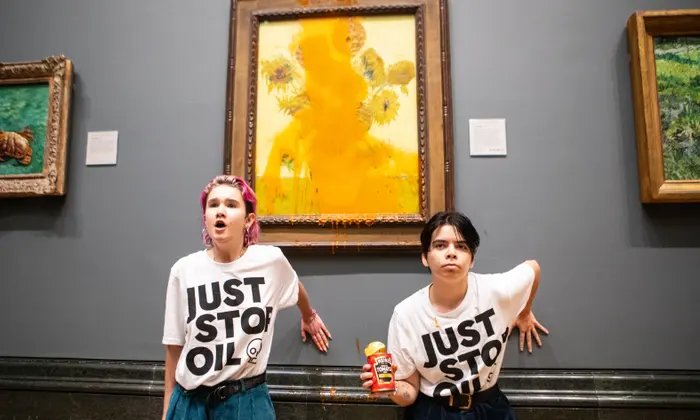Activism or Vandalism: Protesters’ Fiery Attempts at Change
All over the world, famous paintings have fallen victim to climate protesters’ unapologetic attempts to raise awareness of environmental damages caused by various governmental decisions. With these stunts seizing immediate international fame, the public is left to question whether these displays are a noble effort to save the planet or futile vandalistic attacks.
In the most recent demonstration, taking place Oct. 23, protesters affiliated with activist group Letzte Generation threw mashed potatoes on Claude Monet’s “Grainstacks” at the Barberini Museum in Potsdam, Germany. Not too long before, on Oct. 14, a pair of activists from Just Stop Oil hurled tomato soup at Van Gogh’s “Sunflowers” before gluing their hands to the wall beneath the painting. Between DaVinci’s “Mona Lisa” and Vermeer’s “Girl with a Pearl Earring”, these historic pieces of art are now analogous to the destruction of something priceless: the planet.
“We are in a climate catastrophe, and all you are afraid of is tomato soup or mashed potatoes on a painting,” shouted activist Mirjam Herrmann after spattering the Monet. “When will you finally listen and stop business as usual?”
Climate activists have gone to great lengths to spread their message about environmental concerns and goals, but this clear uptick in art-based activism has been a more rapid development with the ever-changing planetary conditions. Additionally, it is thought that the British government’s move to allow oil and gas companies access to new drilling locations has prompted activists to take more radical measures to reach headlines.
“I recognize that it looks like a slightly ridiculous action,” activist Phoebe Plummer said in an interview the day after she appeared in court for her defacement of “Sunflowers”. “I agree; it is ridiculous. But we’re not asking the question if everyone should be throwing soup on paintings. What we’re doing is getting the conversation going so we can ask the questions that matter.”
Art-based activism hasn’t been the only form of climate protest in recent years. Activist group Just Stop Oil has been blocking London roads for months, resulting in 576 arrests. Protesters have scaled support cables on the Queen Elizabeth II Bridge outside of city, smeared cake on a wax sculpture of King Charles III at Madame Tussauds, splashed paint on headquarters of US fossil fuels lobbying group, and sprayed the chancellery in Berlin with an oil-like substance.
“The aim of a lot of these actions is to get a platform that thousands or more people are watching so that they can communicate very clear lines — that the climate crisis is happening, it’s bad, and we all need to wake up,” Chris Saltmarsh, a climate activist and author of “Burnt: Fighting for Climate Justice” told NBC News.
Overall, activists’ goal of reaching international audiences is certainly attained, sparking worldwide conversations about the morality and effectiveness of their methods. Many people have found art-based stunts as destructive and useless; British Foreign Secretary James Cleverly even wrote online that people should stop indulging “adult-toddlers” with the attention they clearly desire. Despite this, many believe the tactics are necessary.
“They’re not killing anyone,” Irish musician Bob Geldof told Sky News. “Climate change will.”
Climate change is one of society’s most prevalent issues, and many are concerned with the lack of progress being made. Still, these destructive forms of protest have supplied the volatile discussion with even more moral uncertainties: how far should we be willing to go to make a change?
“How do you feel when you see something beautiful and priceless being apparently destroyed before your very eyes?” one activist associated with the defacement of the Vermeer painting said. “That is that same feeling when you see the planet being destroyed.”

Addy Cowley is a senior and the "Bulldog Tribune"’s EIC, the president for Cards4Cause, and the secretary of Key Club. She grew up in four countries,...


